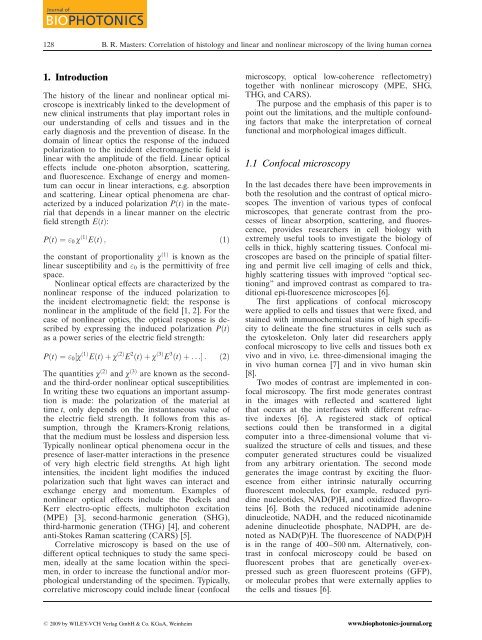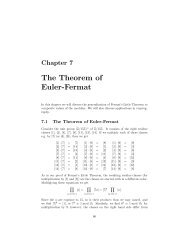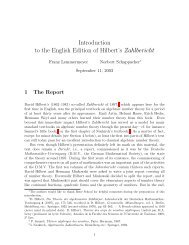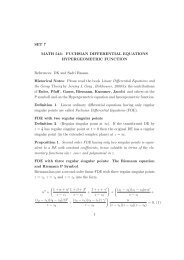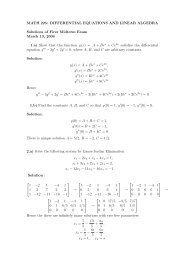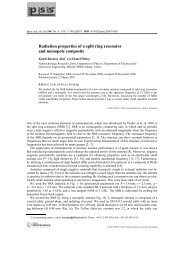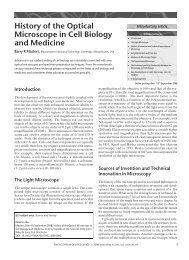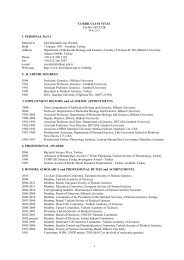Correlation of histology and linear and nonlinear microscopy of the ...
Correlation of histology and linear and nonlinear microscopy of the ...
Correlation of histology and linear and nonlinear microscopy of the ...
You also want an ePaper? Increase the reach of your titles
YUMPU automatically turns print PDFs into web optimized ePapers that Google loves.
Journal <strong>of</strong><br />
BIOPHOTONICS<br />
128<br />
1. Introduction<br />
B. R. Masters: <strong>Correlation</strong> <strong>of</strong> <strong>histology</strong> <strong>and</strong> <strong>linear</strong> <strong>and</strong> non<strong>linear</strong> <strong>microscopy</strong> <strong>of</strong> <strong>the</strong> living human cornea<br />
The history <strong>of</strong> <strong>the</strong> <strong>linear</strong> <strong>and</strong> non<strong>linear</strong> optical microscope<br />
is inextricably linked to <strong>the</strong> development <strong>of</strong><br />
new clinical instruments that play important roles in<br />
our underst<strong>and</strong>ing <strong>of</strong> cells <strong>and</strong> tissues <strong>and</strong> in <strong>the</strong><br />
early diagnosis <strong>and</strong> <strong>the</strong> prevention <strong>of</strong> disease. In <strong>the</strong><br />
domain <strong>of</strong> <strong>linear</strong> optics <strong>the</strong> response <strong>of</strong> <strong>the</strong> induced<br />
polarization to <strong>the</strong> incident electromagnetic field is<br />
<strong>linear</strong> with <strong>the</strong> amplitude <strong>of</strong> <strong>the</strong> field. Linear optical<br />
effects include one-photon absorption, scattering,<br />
<strong>and</strong> fluorescence. Exchange <strong>of</strong> energy <strong>and</strong> momentum<br />
can occur in <strong>linear</strong> interactions, e.g. absorption<br />
<strong>and</strong> scattering. Linear optical phenomena are characterized<br />
by a induced polarization PðtÞ in <strong>the</strong> material<br />
that depends in a <strong>linear</strong> manner on <strong>the</strong> electric<br />
field strength EðtÞ:<br />
PðtÞ ¼"0 c ð1Þ EðtÞ ; ð1Þ<br />
<strong>the</strong> constant <strong>of</strong> proportionality c ð1Þ is known as <strong>the</strong><br />
<strong>linear</strong> susceptibility <strong>and</strong> "0 is <strong>the</strong> permittivity <strong>of</strong> free<br />
space.<br />
Non<strong>linear</strong> optical effects are characterized by <strong>the</strong><br />
non<strong>linear</strong> response <strong>of</strong> <strong>the</strong> induced polarization to<br />
<strong>the</strong> incident electromagnetic field; <strong>the</strong> response is<br />
non<strong>linear</strong> in <strong>the</strong> amplitude <strong>of</strong> <strong>the</strong> field [1, 2]. For <strong>the</strong><br />
case <strong>of</strong> non<strong>linear</strong> optics, <strong>the</strong> optical response is described<br />
by expressing <strong>the</strong> induced polarization PðtÞ<br />
as a power series <strong>of</strong> <strong>the</strong> electric field strength:<br />
PðtÞ ¼"0½c ð1Þ EðtÞþc ð2Þ E 2 ðtÞþc ð3Þ E 3 ðtÞþ...Š : ð2Þ<br />
The quantities c ð2Þ <strong>and</strong> c ð3Þ are known as <strong>the</strong> second<strong>and</strong><br />
<strong>the</strong> third-order non<strong>linear</strong> optical susceptibilities.<br />
In writing <strong>the</strong>se two equations an important assumption<br />
is made: <strong>the</strong> polarization <strong>of</strong> <strong>the</strong> material at<br />
time t, only depends on <strong>the</strong> instantaneous value <strong>of</strong><br />
<strong>the</strong> electric field strength. It follows from this assumption,<br />
through <strong>the</strong> Kramers-Kronig relations,<br />
that <strong>the</strong> medium must be lossless <strong>and</strong> dispersion less.<br />
Typically non<strong>linear</strong> optical phenomena occur in <strong>the</strong><br />
presence <strong>of</strong> laser-matter interactions in <strong>the</strong> presence<br />
<strong>of</strong> very high electric field strengths. At high light<br />
intensities, <strong>the</strong> incident light modifies <strong>the</strong> induced<br />
polarization such that light waves can interact <strong>and</strong><br />
exchange energy <strong>and</strong> momentum. Examples <strong>of</strong><br />
non<strong>linear</strong> optical effects include <strong>the</strong> Pockels <strong>and</strong><br />
Kerr electro-optic effects, multiphoton excitation<br />
(MPE) [3], second-harmonic generation (SHG),<br />
third-harmonic generation (THG) [4], <strong>and</strong> coherent<br />
anti-Stokes Raman scattering (CARS) [5].<br />
Correlative <strong>microscopy</strong> is based on <strong>the</strong> use <strong>of</strong><br />
different optical techniques to study <strong>the</strong> same specimen,<br />
ideally at <strong>the</strong> same location within <strong>the</strong> specimen,<br />
in order to increase <strong>the</strong> functional <strong>and</strong>/or morphological<br />
underst<strong>and</strong>ing <strong>of</strong> <strong>the</strong> specimen. Typically,<br />
correlative <strong>microscopy</strong> could include <strong>linear</strong> (confocal<br />
<strong>microscopy</strong>, optical low-coherence reflectometry)<br />
toge<strong>the</strong>r with non<strong>linear</strong> <strong>microscopy</strong> (MPE, SHG,<br />
THG, <strong>and</strong> CARS).<br />
The purpose <strong>and</strong> <strong>the</strong> emphasis <strong>of</strong> this paper is to<br />
point out <strong>the</strong> limitations, <strong>and</strong> <strong>the</strong> multiple confounding<br />
factors that make <strong>the</strong> interpretation <strong>of</strong> corneal<br />
functional <strong>and</strong> morphological images difficult.<br />
1.1 Confocal <strong>microscopy</strong><br />
In <strong>the</strong> last decades <strong>the</strong>re have been improvements in<br />
both <strong>the</strong> resolution <strong>and</strong> <strong>the</strong> contrast <strong>of</strong> optical microscopes.<br />
The invention <strong>of</strong> various types <strong>of</strong> confocal<br />
microscopes, that generate contrast from <strong>the</strong> processes<br />
<strong>of</strong> <strong>linear</strong> absorption, scattering, <strong>and</strong> fluorescence,<br />
provides researchers in cell biology with<br />
extremely useful tools to investigate <strong>the</strong> biology <strong>of</strong><br />
cells in thick, highly scattering tissues. Confocal microscopes<br />
are based on <strong>the</strong> principle <strong>of</strong> spatial filtering<br />
<strong>and</strong> permit live cell imaging <strong>of</strong> cells <strong>and</strong> thick,<br />
highly scattering tissues with improved “optical sectioning”<br />
<strong>and</strong> improved contrast as compared to traditional<br />
epi-fluorescence microscopes [6].<br />
The first applications <strong>of</strong> confocal <strong>microscopy</strong><br />
were applied to cells <strong>and</strong> tissues that were fixed, <strong>and</strong><br />
stained with immunochemical stains <strong>of</strong> high specificity<br />
to delineate <strong>the</strong> fine structures in cells such as<br />
<strong>the</strong> cytoskeleton. Only later did researchers apply<br />
confocal <strong>microscopy</strong> to live cells <strong>and</strong> tissues both ex<br />
vivo <strong>and</strong> in vivo, i.e. three-dimensional imaging <strong>the</strong><br />
in vivo human cornea [7] <strong>and</strong> in vivo human skin<br />
[8].<br />
Two modes <strong>of</strong> contrast are implemented in confocal<br />
<strong>microscopy</strong>. The first mode generates contrast<br />
in <strong>the</strong> images with reflected <strong>and</strong> scattered light<br />
that occurs at <strong>the</strong> interfaces with different refractive<br />
indexes [6]. A registered stack <strong>of</strong> optical<br />
sections could <strong>the</strong>n be transformed in a digital<br />
computer into a three-dimensional volume that visualized<br />
<strong>the</strong> structure <strong>of</strong> cells <strong>and</strong> tissues, <strong>and</strong> <strong>the</strong>se<br />
computer generated structures could be visualized<br />
from any arbitrary orientation. The second mode<br />
generates <strong>the</strong> image contrast by exciting <strong>the</strong> fluorescence<br />
from ei<strong>the</strong>r intrinsic naturally occurring<br />
fluorescent molecules, for example, reduced pyridine<br />
nucleotides, NAD(P)H, <strong>and</strong> oxidized flavoproteins<br />
[6]. Both <strong>the</strong> reduced nicotinamide adenine<br />
dinucleotide, NADH, <strong>and</strong> <strong>the</strong> reduced nicotinamide<br />
adenine dinucleotide phosphate, NADPH, are denoted<br />
as NAD(P)H. The fluorescence <strong>of</strong> NAD(P)H<br />
is in <strong>the</strong> range <strong>of</strong> 400–500 nm. Alternatively, contrast<br />
in confocal <strong>microscopy</strong> could be based on<br />
fluorescent probes that are genetically over-expressed<br />
such as green fluorescent proteins (GFP),<br />
or molecular probes that were externally applies to<br />
<strong>the</strong> cells <strong>and</strong> tissues [6].<br />
# 2009 by WILEY-VCH Verlag GmbH & Co. KGaA, Weinheim www.biophotonics-journal.org


